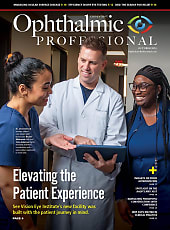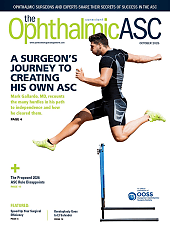For this month's Retina Minute, I have the pleasure of interviewing my dear friend, Dr. Jay Chhablani, who is a retina specialist at the University of Pittsburgh Medical Center Vision Institute, professor of ophthalmology, and vice chair for clinical trials.
Dr. Chhablani, recently at EURETINA, you presented some interesting data. Can you tell our readership about it?
I presented a phase 1/2 study update for Ocugen's OCU410 molecule for geographic atrophy (GA). OCU410 is a single subretinal gene therapy. It is a modified therapeutic approach for dry macular degeneration, and it works with 4 mechanisms. It has antidrusen activity, which works through lipid metabolisms, and it has antioxidant, anti-inflammatory, and anticomplement activity. The study was started with a phase 1 of a dose escalation trial in which patients were divided into 3 groups: low dose, medium dose, and high dose. Each of these dosing groups had 3 subjects, which led to a dose expansion study in phase 2 where we excluded the low dose but kept the medium and high doses and the control arm. Each of these arms had 17 patients enrolled.
The key inclusion/exclusion criteria were typical for most GA trials, and considering that this was a phase 1/2 study, the main outcome measures were focused toward safety. Efficacy was the secondary outcome. On the baseline characteristics, we had subjects with BCVA of better than 21 letters.
We did not see any serious adverse events post-OCU410, though there were typical procedure-related side effects. One patient had partial foveal detachment early in the study, and then the surgical procedure was changed where we did peripheral blebs. We saw a 23% slower GA lesion growth in the study eye compared to fellow eyes in the phase 1 data, which was already completed at 12 months. In terms of the visual function, luminance visual acuity showed an improvement or stabilization of 2 lines in the study eye compared to fellow eyes.
And just to give you a little bit of an update on phase 2 study design: Enrollment is completed, interim 6-month results show 27% slower GA lesion growth compared to fellow eyes, and we noticed a significant benefit over the approved drugs for GA. In additional analyses, we also noticed benefits on optical coherence tomography regarding retinal pigment epithelium atrophy and ellipsoid zone loss.
Are multiple blebs or a singular bleb made, and where is the area of the bleb made?
We made the blebs in the far periphery in the inferior or infratemporal areas beyond the equatorial region. We aimed to make 2 blebs that did not join together.
And was the goal when you made the blebs to infiltrate under the macular region, or stop before you hit the area of atrophy?
We made sure that our blebs did not cross the equator or come close to the arcade.
What gene vector did you use?
We used AAV5.
Was there inflammation, and if so, how much was amenable to steroids? Was there a steroid prophylaxis regimen?
We did not see any inflammation. Oral steroids were given only for a month. We gave topical steroids, as we do for the surgical procedure, but there were no long-term steroids.
In the phase two 2 trial, were there any visual surrogates that showed meaningful change?
Low luminous visual acuity assured the benefit of almost 2 lines. Because this was phase 1 study, the primary outcome measure was safety. We did not see any obvious benefit in terms of the visual acuity on ETDRS letters, though one of my patients did improve by 1.5 lines—around 7 or 8 letters. That was a surprise to me, but there was no significant benefit in visual acuity on average.
What is the next step in this program?
The plan is to start phase 3 by April 2026.
This is fascinating data. As we all know, the complement seems to be the focus in many therapies on the horizon. Having something with multiple mechanisms of action could have the potential of both slowing down lesion growth and potentially showing a visual signal. We are excited about that possibility, and hopefully it will be something we add into our toolbox.
Yes, absolutely. One of my patients who got the treatment said that she stopped seeing the black line that was blocking her vision in the eye we treated, and she is currently at 10 months posttreatment now.
Thank you so much for being here, Dr. Chhablani.
Thank you again for having me.
This editorial content was supported via unrestricted sponsorship.










